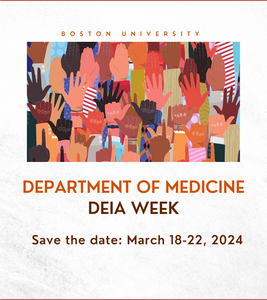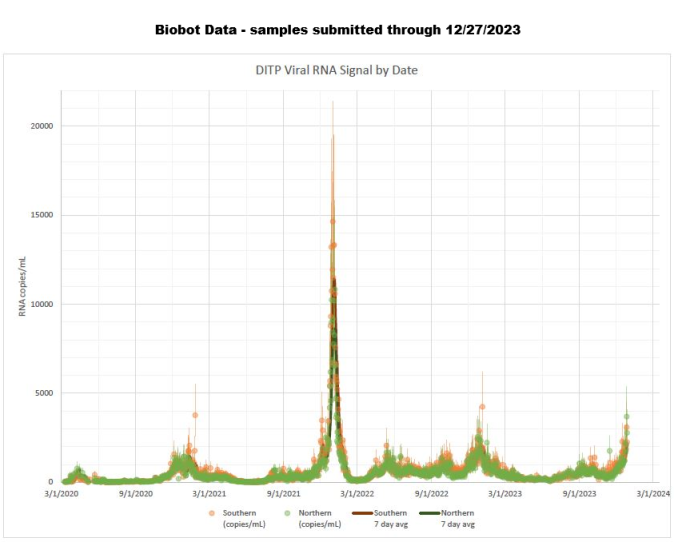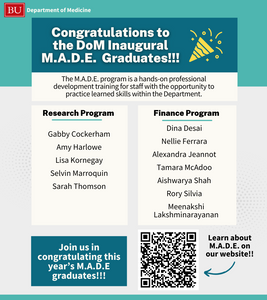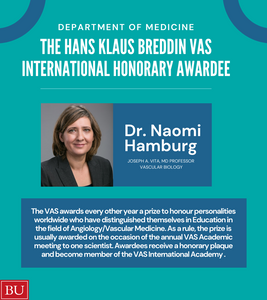We are delighted to announce the AY 24 Evans Junior Faculty Research Merit Awardees.
The awardees for AY 24 are: Tara Bouton, MD, MPH & TM (Infectious Diseases) and Simeon Kimmel, MD, MA (General Internal Medicine). These individuals were selected based on their very strong research accomplishments and exceptional promise as investigators! We had 21 very highly qualified applicants for the award! Although it was difficult to select awardees from such a talented pool of faculty, we can be assured that the number of highly talented junior faculty portends a very bright future for research in the Department of Medicine.
Please join us in offering congratulations to our outstanding AY 24 Evans Junior Faculty Research Merit Awardees!
Senior Residents
Graduating Class of 2024
Gabrielle Barbera, Cardiovascular Disease Fellowship, Rutgers R. W. Johnson Medical School - Newark, NJ
Danielle Bellavance, Chief Medical Resident, Boston Medical Center/VA - Boston, MA
Shreya Bhatia, Geriatric Medicine Fellowship, Boston Medical Center - Boston, MA
Abbi Cerezo, Hospitalist, University of Utah - Salt Lake City, UT
Samantha Chua, Gastroenterology Fellowship, Boston Medical Center - Boston, MA
Alejandro De La Hoz Gomez, Infectious Diseases Fellowship, Massachusetts General Hospital - Boston, MA
Harshitha Dudipala, Hematology & Oncology Fellowship, University of California San Diego - San Diego, CA
Benjamin Eromosele, Chief Medical Resident, Boston Medical Center/VA - Boston, MA
Adriana Flores, Pulmonary & Critical Care Fellowship, Boston Medical Center - Boston, MA
Taylor Francoeur, Hematology & Oncology Fellowship, University of Massachusetts - Worcester, MA
Rohan Ganti, Cardiovascular Disease Fellowship, Rutgers, R. W. Johnson Medical School - Newark, NJ
Philip Hewes, Hospice & Palliative Medicine Fellowship, University of Massachusetts - Worcester, MA
Garen Kroshian, Cardiovascular Disease, Boston Medical Center - Boston, MA
Alan Manivannan, Quality Improvement and Patient Safety Fellowship, Boston Medical Center - Boston, MA
Zachary Milstone, PRIMER Research Chief Resident, Boston Medical Center - Boston, MA
Connor O’Neill-Dee, Nephrology Fellowship, Boston Medical Center - Boston, MA
Sahaj Patel, Hospice & Palliative Medicine Fellowship, Weill Cornell Medicine-Cornell University - New York, NY
Scott Place, Chief Medical Resident, Boston Medical Center/VA - Boston, MA
Max Rosenthaler, Chief Medical Resident, Boston Medical Center/VA - Boston, MA
Caroline Ross, Chief Medical Resident, Boston Medical Center/VA - Boston, MA
Sabetta Singh, Chief Medical Resident, Boston Medical Center/VA - Boston, MA
Quinn Solfisburg, Hematology & Oncology Fellowship, Boston Medical Center - Boston, MA
Natalie Sun, Gastroenterology Fellowship, SUNY Downstate - Brooklyn, NY
Abigail Tami, Gastroenterology Fellowship, Geisinger Health System - Danville, PA
Carly Taylor, Hospitalist, Boston Medical Center - Boston, MA
Tracey Yee, Cardiovascular Disease Fellowship, University of Vermont - Burlington, VT
Marcel Yibirin Wakim, Chief Medical Resident, Boston Medical Center/VA - Boston, MA
Chief Medical Resident
Graduating Class 2023
Laura Burns, Hematology & Oncology Fellowship, MD Anderson Cancer Center - Houston, TX
Sophie Claudel, Nephrology Fellowship, Boston Medical Center - Boston, MA
Chad Hinkle, Infectious Disease Fellowship, University of Chicago - Chicago, IL
Juan Rodriguez, Pulmonary & Critical Care Fellowship, Boston Medical Center - Boston, MA
Esther Saul, Pulmonary & Critical Care Fellowship, Boston Medical Center - Boston, MA
Ayelet Shapira-Daniels, Cardiovascular Disease Fellowship, Boston Medical Center - Boston, MA
Karina Verma, Hematology & Oncology Fellowship, Boston Medical Center - Boston, MA
Alex Yeo, Pulmonary & Critical Care Fellowship, Boston Medical Center - Boston, MA
Alumni
Jinal Gandhi, Hematology & Oncology Fellowship, Montefiore Medical Center-Einstein - Bronx, NY
Daniel Gonzalez Izundegui, Cardiovascular Disease Fellowship, University of Texas Southwestern-Dallas - Dallas, TX
Claude Hardy, Addiction Medicine Fellowship, Massachusetts General Hospital - Boston, MA
Abdulaziz Malik, Clinical Cardiac Electrophysiology Fellowship, Tufts Medical Center - Boston, MA
Emily Mann, Hematology & Oncology Fellowship, Boston Medical Center - Boston, MA
Kaitlin McCarter, Rheumatology Fellowship, Brigham & Women’s Hospital - Boston, MA
Kristina Moller, Hospice & Palliative Medicine, Beth Israel Deaconess Medical Center - Boston, MA
Sofia Shaikh, Gastroenterology Fellowship, University of Rochester - Rochester, NY
Jasmine Vakhshoorzadeh, Pulmonary & Critical Care Fellowship, University of Pittsburgh - Pittsburgh, PA
The DoM will hold its first annual Diversity, Equity, Inclusion and Accessibility Week the week of March 18, 2024. In the DoM, we are dedicated to fostering a workplace that values and celebrates diversity, promotes equity, ensures inclusion, and prioritizes accessibility. We firmly believe that our collective differences make us stronger, and we are committed to creating an environment where all individuals, regardless of their background, feel valued, respected, and empowered.
Please join us in celebrating and educating our community about a wide range of identities and backgrounds that make individuals in our department unique.

DECEMBER 8, 2023 (Boston) – Boston Medical Center (BMC), a national leader in the treatment of sickle cell disease for more than 50 years, announced today that it will offer the first-ever gene therapies for sickle cell disease, including one that uses a type of novel genome editing technology. The new therapies leverage the latest advances in medical science to alleviate the severe painful vaso-occlusive crises (VOCs) associated with sickle cell disease, in a long-awaited step toward equity for a disproportionally impacted Black patient population.
The announcement comes as the FDA today granted approval of a new gene editing therapy, jointly developed by Boston-based Vertex Pharmaceuticals and CRISPR Therapeutics of Switzerland, along with approval of a separate gene therapy developed by bluebird bio of Somerville, Mass., for sickle cell disease. BMC is the only hospital in New England to offer the therapies to eligible adults with sickle cell disease.
“Boston Medical Center has a longstanding commitment to providing advanced clinical care to those with sickle cell disease,” said Dr. Jean-Antoine Ribeil, MD, PhD, Clinical Director of the Center of Excellence in Sickle Cell Disease at Boston Medical Center and an internationally renowned hematologist who has dedicated his career to the development of gene therapies for patients with sickle cell disease and beta thalassemia. “The new gene therapies can be life changing for eligible patients who are impacted by sickle cell disease and the extreme pain that it causes, with previously limited treatment options.”
Sickle cell disease is a debilitating and chronic disease that afflicts more than 100,000 Americans and predominantly impacts people of African descent, representing 1 out of every 365 births. The disease is caused by a gene mutation that makes blood cells misshapen which can lead to strokes, organ damage and episodes of agonizing pain. Those with sickle cell disease often rely on regular blood transfusions to ease pain and reduce risk of additional complications.
The new Vertex Pharmaceuticals treatment is the first therapy to treat a genetic disease with the CRISPR gene-editing technique. Vertex began clinical trials on the therapy in the United States in 2018. The SCD clinical trial enrolled a patient population that was predominantly of African ancestry. The FDA reviewed the safety and effectiveness of the treatment in that trial before today’s approval.
Bluebird bio’s new therapy, also approved by the FDA following clinical trials, is a one-time gene therapy that has the potential to resolve vaso-occlusive events and is custom-designed to treat the underlying cause of sickle cell disease.
Both treatments will be offered to select, eligible adult sickle cell patients at BMC as part of its Center of Excellence in Sickle Cell Disease, which is the largest center of its kind in New England, serving approximately 600 adult and pediatric patients annually. The introduction of these therapies gives those with sickle cell disease more options to try to achieve a life without chronic pain.
The BMC Center of Excellence in Sickle Cell Disease has long taken an innovative and multidisciplinary approach to caring for patients suffering from this debilitating disease. The Center pairs hematologists with specialists, such as pulmonologists, nephrologists, and primary care doctors who understand the needs and many complications of patients with sickle cell disease. The addition of cutting-edge gene therapy to its suite of services reflects BMC’s ongoing commitment to this population and to being a leader in offering advanced, equitable care to its patients.
For more information on BMC’s Center of Excellence in Sickle Cell Disease visit their website or connect on Facebook, Instagram, X (formerly Twitter), and LinkedIn.
Original Article
SAN DIEGO — The Spondyloarthritis Research and Treatment Network (SPARTAN) has created the first referral recommendations for axial spondyloarthritis (axSpA).
The draft recommendations use a points scoring system, with the goal that at least 1 in 3 patients referred would be diagnosed with axSpA, an inflammatory arthritis that affects the central skeleton and shares a genetic overlap with skin psoriasis, inflammatory bowel disease, and inflammatory eye disease.
Patients with axSpA can wait 10 years after symptom onset to be diagnosed with the condition. There are currently no guidelines to advise clinicians on when to refer to a rheumatologist, and with the rheumatology workforce shortage, "it is impossible for rheumatologists to evaluate the 20% of adults in the US who have chronic back pain," said Maureen Dubreuil, MD, a rheumatologist at Boston University. She presented the work at the American College of Rheumatology (ACR) 2023 Annual Meeting.
Continue reading here.




